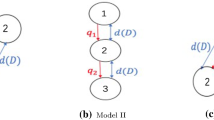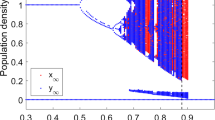Abstract
We investigate the impact of Allee effect and dispersal on the long-term evolution of a population in a patchy environment. Our main focus is on whether a population already established in one patch either successfully invades an adjacent empty patch or undergoes a global extinction. Our study is based on the combination of analytical and numerical results for both a deterministic two-patch model and a stochastic counterpart. The deterministic model has either two, three or four attractors. The existence of a regime with exactly three attractors only appears when patches have distinct Allee thresholds. In the presence of weak dispersal, the analysis of the deterministic model shows that a high-density and a low-density populations can coexist at equilibrium in nearby patches, whereas the analysis of the stochastic model indicates that this equilibrium is metastable, thus leading after a large random time to either a global expansion or a global extinction. Up to some critical dispersal, increasing the intensity of the interactions leads to an increase of both the basin of attraction of the global extinction and the basin of attraction of the global expansion. Above this threshold, for both the deterministic and the stochastic models, the patches tend to synchronize as the intensity of the dispersal increases. This results in either a global expansion or a global extinction. For the deterministic model, there are only two attractors, while the stochastic model no longer exhibits a metastable behavior. In the presence of strong dispersal, the limiting behavior is entirely determined by the value of the Allee thresholds as the global population size in the deterministic and the stochastic models evolves as dictated by their single-patch counterparts. For all values of the dispersal parameter, Allee effects promote global extinction in terms of an expansion of the basin of attraction of the extinction equilibrium for the deterministic model and an increase of the probability of extinction for the stochastic model.
Similar content being viewed by others
References
Ackleh AS, Allen LJS, Carter J (2007) Establishing a beachhead: a stochastic population model with an Allee effect applied to species invasion. Theor Popul Biol 71: 290–300
Adler RF (1993) Migration alone can produce persistence of host-parasitoid models. Am Nat 141: 642–650
Amarasekare P (1998a) Allee effects in metapopulation dynamics. Am Nat 152: 298–302
Amarasekare P (1998b) Interactions between local dynamics and dispersal: insights from single species models. Theor Popul Biol 53: 44–59
Amarasekare P (2000) The geometry of coexistence. Biol J Linn Soc 71: 1–31
Berec L, Boukal DS, Berec M (2001) Linking the Allee effect, sexual reproduction, and temperature-dependent sex determination via spatial dynamics. Am Nat 157: 217–230
Berec L, Angulo E, Courchamp F (2007) Multiple Allee effects and population management. Trends Ecol Evol 22: 185–191
Clark BR, Faeth SH (1997) The consequences of larval aggregation in the butterfly Chlosyne lacinia. Ecol Entomol 22: 408–415
Courchamp F, Berec L, Gascoigne J (2009) Allee effects in ecology and conservation. Oxford University Press, Oxford
Dennis B (1989) Allee effects, population growth critical density and the chance of extinction. Natural Resource Modeling 3: 481–538
Dennis B (2002) Allee effects in stochastic populations. Oikos 96: 389–401
Dercole F, Ferrière R, Rinaldi S (2002) Ecological bistability and evolutionary reversals under asymmetrical competition. Evolution 56: 1081–1090
Drake JM (2004) Allee effects and the risk of biological invasion. Risk Anal 24: 795–802
Fagan WF, Lewis MA, Neubert MG, van den Driessche P (2002) Invasion theory and biological control. Ecol Lett 5: 148–157
Gascoigne JC, Lipcius RN (2004) Allee effects driven by predation. J Appl Ecol 41: 801–810
Greene C, Stamps JA (2001) Habitat selection at low population densities. Ecology 82: 2091–2100
Guckenheimer J, Holmes P (1983) Nonlinear oscillations, dynamical systems, and bifurcations of vector fields. Springer, New York
Gyllenberg M, Hemminki J, Tammaru T (1999) Allee effects can both conserve and create spatial heterogeneity in population densities. Theor Popul Biol 56: 231–242
Harris TE (1972) Nearest neighbor Markov interaction processes on multidimensional lattices. Adv Math 9: 66–89
Hopper KR, Roush RT (1993) Mate finding, dispersal, number released, and the success of biological control introductions. Ecol Entomol 18: 321–331
Johnson DM, Liebhold AM, Tobin PC, Bjornstad ON (2006) Allee effects and pulsed invasion by the gypsy moth. Nature 444: 361–363
Kang Y, Armbruster D (2010) Dispersal effect on a two-patch plant-insect interactions model with Allee-like effects. (Preprint, under review)
Keitt TH, Lewis MA, Holt RD (2001) Allee effects, invasion pinning, and species’ borders. Am Nat 157: 203–216
Krone SM (1999) The two-stage contact process. Ann Appl Probab 9: 331–351
Lande R (1998) Anthropogenic, ecological and genetic factors in extinction and conservation. Res Popul Ecol 40: 259–269
Leung B, Drake JM, Lodge DM (2004) Predicting invasions: propagule pressure and the gravity of Allee effects. Ecology 85: 1651–1660
Levin SA (1974) Dispersion and population interactions. Am Nat 108: 207–228
Liebhold A, Bascompte J (2003) The Allee effect, stochastic dynamics and the eradication of alien species. Ecol Lett 6: 133–140
Liebhold A, Tobin PC (2008) Population ecology of insect invasions and their management. Ann Rev Entomol 53: 387–408
McCarthy MA (1997) The Allee effect, finding mates and theoretical models. Ecol Model 103: 99–102
Petrovskii S, Morozov A, Li B-L (2005) Regimes of biological invasion in a predator-prey system with the Allee effect. Bull Math Biol 67: 637–661
Schreiber S (2003) Allee effects, extinctions, and chaotic transients in simple population models. Theor Popul Biol 64: 201–209
Shigesada N, Kawasaki K (1997) Introduction. In: Shigesada N, Kawasaki K (eds) Biological invasions: theory and practice. Oxford University Press, New York, pp 1–5
Stephens PA, Sutherland WJ (1999) Consequences of the Allee effect for behaviour, ecology and conservation. Trends Ecol Evol 14: 401–405
Taylor CM, Hastings A (2005) Allee effects in biological invasions. Ecol Lett 8: 895–908
Tobin PC, Whitmire SL, Johnson DM, Bjrnstad ON, Liebhold AM (2007) Invasion speed is affected by geographical variation in the strength of Allee effects. Ecol Lett 10: 36–43
Veit RR, Lewis MA (1996) Dispersal, population growth, and the Allee effect: dynamics of the house finch invasion of eastern North America. Am Nat 148: 255–274
Wang MH, Kot M, Neubert MG (2002) Integrodifference equations, Allee effects, and invasions. J Math Biol 44: 150–168
Zhou SR, Liu CZ, Wang G (2004) The competitive dynamics of metapopulation subject to the Allee-like effect. Theor Popul Biol 65: 29–37
Author information
Authors and Affiliations
Corresponding author
Rights and permissions
About this article
Cite this article
Kang, Y., Lanchier, N. Expansion or extinction: deterministic and stochastic two-patch models with Allee effects. J. Math. Biol. 62, 925–973 (2011). https://doi.org/10.1007/s00285-010-0359-3
Received:
Revised:
Published:
Issue Date:
DOI: https://doi.org/10.1007/s00285-010-0359-3
Keywords
- Allee effect
- Deterministic model
- Stochastic model
- Extinction
- Expansion
- Invasion
- Bistability
- Basin of attraction
- Metastability




